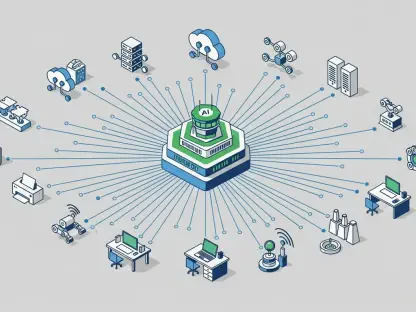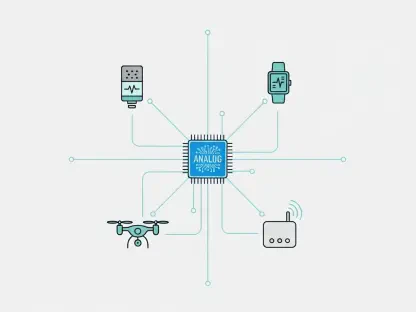The rapid evolution of technology has ushered in an era where businesses across the globe are increasingly relying on automation to stay competitive, and nowhere is this more evident than in the burgeoning field of Robotic Process Automation (RPA). This innovative approach, which leverages software robots and artificial intelligence to handle repetitive, rule-based tasks, is transforming industries by slashing operational costs and boosting efficiency. From finance to healthcare, organizations are embracing RPA to minimize human error and streamline processes, setting the stage for a monumental shift in how work is conducted. As the market is projected to experience significant expansion from now through 2035, understanding the forces driving this growth, the challenges that lie ahead, and the opportunities for innovation becomes essential for stakeholders aiming to capitalize on this transformative trend.
Driving Forces Behind Market Expansion
Technological Advancements Fueling Growth
The integration of cutting-edge technologies such as artificial intelligence and machine learning with RPA systems is a primary catalyst for the market’s anticipated surge over the next decade. These advancements enable the automation of increasingly complex tasks, extending the applicability of RPA beyond simple data entry to intricate decision-making processes. Industries like manufacturing and financial services are already witnessing a profound impact, as intelligent automation solutions adapt to dynamic environments and deliver precise outcomes. This technological synergy not only enhances productivity but also positions RPA as a cornerstone of digital transformation strategies, allowing companies to remain agile in a fast-paced business landscape. The continuous evolution of these tools promises to unlock new possibilities, ensuring that automation becomes a fundamental component of operational frameworks across diverse sectors.
Rising Demand for Efficiency and Cost Reduction
Another significant driver propelling the RPA market forward is the pressing need for cost-effective solutions amid intensifying global competition. Businesses are under constant pressure to optimize operations while maintaining high standards of accuracy, and RPA offers a compelling answer by automating mundane tasks that traditionally consume substantial time and resources. This shift is particularly evident in sectors with high transaction volumes, where even small efficiency gains translate into substantial savings. Furthermore, the push for digital transformation has accelerated adoption rates, as organizations recognize the strategic advantage of reducing human error and reallocating talent to more value-driven activities. As companies navigate economic uncertainties, the ability of RPA to deliver measurable returns on investment continues to drive its widespread implementation, shaping a future where automation is synonymous with business resilience.
Challenges and Opportunities on the Horizon
Navigating Implementation Costs and Security Concerns
Despite the promising outlook, the path to widespread RPA adoption is not without hurdles, particularly for small and medium-sized enterprises grappling with the high initial costs of implementation. Deploying these systems often requires significant upfront investment in software, infrastructure, and training, which can be a barrier for organizations with limited budgets. Additionally, concerns over data security loom large, as automating sensitive processes raises the risk of breaches and compliance issues. Addressing these challenges necessitates robust cybersecurity measures and scalable solutions tailored to varying business sizes. Vendors and service providers must prioritize developing cost-effective models and reassuring clients about data protection to foster trust and encourage broader uptake. Overcoming these obstacles will be crucial for ensuring that the benefits of RPA are accessible to a wider range of enterprises.
Exploring Hyper-Automation and Emerging Markets
On the flip side, the RPA landscape is ripe with opportunities, particularly through the advent of hyper-automation, which integrates RPA with complementary technologies to automate end-to-end processes. This holistic approach promises to revolutionize business operations by creating seamless workflows that enhance both speed and accuracy, offering a glimpse into the future of work. Simultaneously, emerging markets in regions like Asia-Pacific present untapped potential, driven by rapid industrialization and growing investments in IT infrastructure. Countries such as China and India are poised to become hotspots for RPA growth, fueled by a demand for operational efficiency amid expanding economies. Capitalizing on these opportunities requires strategic focus from market players to tailor solutions to regional needs and cultural nuances. As these markets mature, they are likely to play a pivotal role in shaping the global trajectory of automation technologies.
Global Perspectives and Regional Dynamics
North America’s Leadership in Adoption
North America stands at the forefront of the RPA market, largely due to the early embrace of automation technologies and a robust technological infrastructure, particularly in the United States. This region benefits from a mature ecosystem of tech-savvy enterprises and supportive policies that encourage innovation, making it a hub for major players and startups alike. The emphasis on streamlining complex business processes in industries like finance and healthcare has cemented North America’s position as a leader, with companies leveraging RPA to maintain a competitive edge. Additionally, the presence of established vendors fosters a culture of continuous improvement, driving the development of next-generation solutions. As the market evolves through 2035, this region is expected to sustain its dominance by setting benchmarks for adoption and implementation standards that influence global trends.
Asia-Pacific’s Rapid Rise in Automation
In contrast, the Asia-Pacific region is emerging as the fastest-growing market for RPA, propelled by swift industrialization and significant investments in digital infrastructure. Nations like China and India are experiencing a surge in demand for automation solutions as businesses strive to enhance productivity amid expanding operations. The region’s diverse economic landscape, coupled with a focus on cost efficiency, makes RPA an attractive proposition for organizations seeking to modernize without breaking the bank. Government initiatives to promote technology adoption further accelerate this growth, creating a fertile ground for innovation. As Asia-Pacific continues to bridge the gap with more developed markets, its role in shaping the future of RPA cannot be understated, with projections indicating a transformative impact on global market dynamics over the coming years.
Reflecting on a Decade of Transformation
Looking back, the journey of the RPA market reveals a landscape reshaped by relentless innovation and an unwavering commitment to efficiency. The strides made in integrating artificial intelligence with automation tools marked a turning point, enabling businesses to tackle intricate challenges with unprecedented precision. Regional disparities, while evident, highlighted the universal appeal of cost reduction and productivity gains that RPA delivered. As companies navigated past hurdles like the disruptions of global crises, their adaptive strategies—such as embracing cloud-based solutions—laid a strong foundation for resilience. Moving forward, the focus should shift toward democratizing access to these technologies, ensuring that even smaller enterprises can harness their potential. Exploring partnerships and investing in scalable, secure systems will be key steps to sustaining momentum. Ultimately, the legacy of RPA’s evolution offers a blueprint for future advancements, urging stakeholders to innovate boldly while addressing the nuanced needs of a diverse global market.









